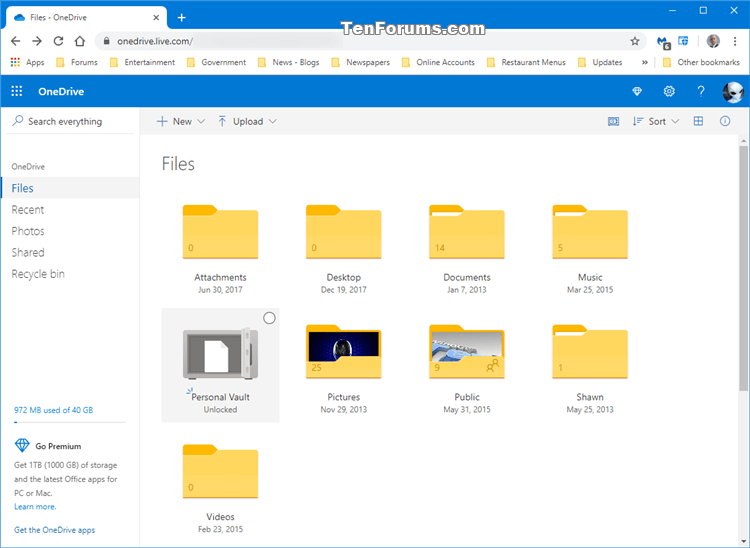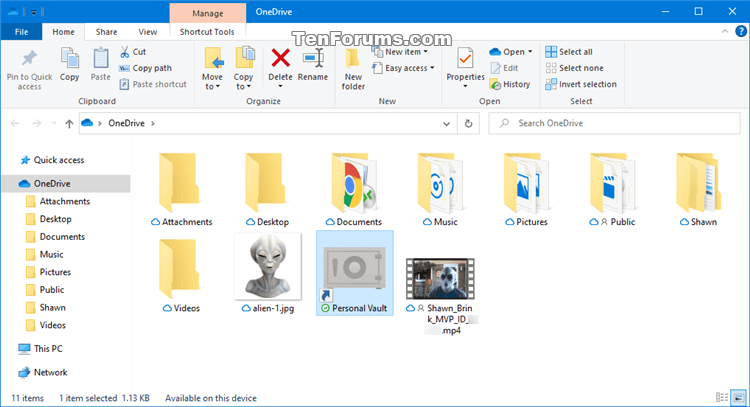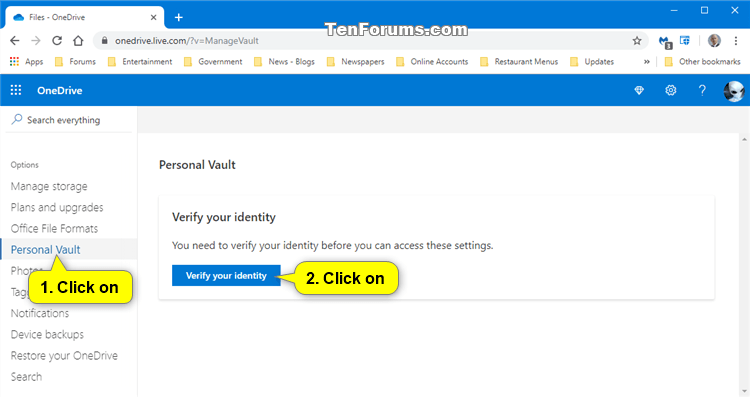How to Enable or Disable Personal Vault in OneDrive and Windows 10
OneDrive is a cloud-based storage service where you can view, browse, upload, and share the files you saved online to OneDrive.
OneDrive runs on the trusted Microsoft cloud, which has many security measures in place to keep your files safe. But Microsoft understands that some people want more protection for their most important and sensitive files, which is why they are introducing Personal Vault.
Personal Vault is a protected area in OneDrive where you can store your most important or sensitive files and photos without sacrificing the convenience of anywhere access.
Personal Vault adds to the robust privacy and security that OneDrive currently offers, including file encryption at rest and in transit, suspicious activity monitoring, ransomware detection and recovery, mass file deletion notification and recovery, virus scanning on download for known threats, and version history for all file types.
You will need to set up OneDrive Personal Vault separately on each device where you want to use it.
Just enter a PIN, or use your fingerprint, face, or a code delivered by email or SMS1 to unlock and access your filesóno need to remember multiple passwords. Additionally, Personal Vault can be unlocked with the Microsoft Authenticator app. Whichever way you choose, unlocking is quick, convenient, and helps secure your data.
Personal Vault uses more than just two-step verification to help keep your files safe and private. On Windows 10 PCs, OneDrive syncs your Personal Vault files to a BitLocker-encrypted area of your local hard drive. And like all files in OneDrive, the contents of your Personal Vault are encrypted at-rest in the Microsoft cloud and in-transit to your device. For further protection on mobile devices, it is recommend that you enable encryption on your iOS or Android device. Together, these measures help keep your files protected even if your Windows 10 PC or mobile device is lost, stolen, or someone gains access to it.
Personal Vault automatically locks after a period of inactivity (20 minutes on the web, 3 minutes on a mobile app) and then you need to unlock it to get at your files again. All your documents, photos, and videos in Personal Vault are easy to access from onedrive.com, your PC, or other capable devices.
These new Personal Vault capabilities will be provided to people who use OneDrive on the web, with the OneDrive mobile app or on a Windows 10 PC. Personal Vault started rolling out in all regions worldwide on September 6, 2019 and is expected to be available to everyone in October. You will know it's available when you see the special Personal Vault folder in OneDrive.
If you already have OneDrive, Personal Vault will appear as a feature update when it launches later this year in your region. And if you arenít yet a OneDrive customer, you can download the app or go to www.onedrive.com to start using it on your PC or on the web. If you are using OneDriveís free or standalone 100 GB plan, you can try Personal Vault with a limited number of files. Office 365 subscribers can store as many files as they want in Personal Vault, up to their storage limit.
If you don't have an Office 365 Home or Personal subscription, you can only add up to three files in your Personal Vault. If you do have a subscription, you can add as many files as you want (up to your storage limit).
See also:
- OneDrive Personal Vault | Microsoft 365
- OneDrive Personal Vault and expandable storage now available worldwide
- Announcing OneDrive Personal Vault and additional storage options
- OneDrive Personal Vault brings added security to your most important files and OneDrive gets additional storage options | Microsoft 365 Blog
- Protect your OneDrive files in Personal Vault | Microsoft Office
This tutorial will show you how to enable (add) or disable (remove) Personal Vault in your OneDrive and Windows 10 PC.
EXAMPLE: Personal Vault in OneDrive (online) and Windows 10

Disabling Personal Vault permanently deletes any files that are in your Personal Vault at the time you disable it. You won't be able to recover these files later.
1 Open your OneDrive online, and sign in if not already.
2 In your OneDrive, click/tap on Settings (gear icon), and click/tap on Options. (see screenshot below)
3 Click/tap on Personal Vault in the left pane. Click/tap on Verify your identity if prompted. (see screenshot below)
A) Select a verification method (ex: text) you want to use to get a security code. (see screenshot below)
B) Enter the required information for the verification method you selected, and click/tap on Send code. (see screenshot below)
C) Enter the security code you received from Microsoft, and click/tap on Verify. (see screenshot below)
4 Click/tap on Personal Vault in the left pane, and click/tap on the Disable link to the right of Disable Personal Vault. (see screenshot below)
5 Click/tap on Disable to verify. (see screenshot below)
6 Click/tap on Disable again to confirm. (see screenshot below)
Disabling Personal Vault permanently deletes any files that are in your Personal Vault at the time you disable it. You won't be able to recover these files later.
OneDrive Personal Vault is enabled by default.
1 Open your OneDrive online, and sign in if not already.
2 In your OneDrive, click/tap on Settings (gear icon), and click/tap on Options. (see screenshot below)
3 Click/tap on Personal Vault in the left pane, and click/tap on Enable. (see screenshot below)
4 Click/tap on Got it. (see screenshot below)
That's it,
Shawn
Related Tutorials
- How to Link or Unlink OneDrive with Microsoft Account in Windows 10
- How to Uninstall OneDrive in Windows 10
- How to Enable or Disable OneDrive Integration in Windows 10
- How to Turn On or Off Start OneDrive Automatically when you Sign in to Windows 10
- How to Set up OneDrive Personal Vault in Windows 10
- How to Unlock OneDrive Personal Vault in Windows 10
- How to Lock OneDrive Personal Vault in Windows 10
- How to Change OneDrive Personal Vault Inactivity Lock Time in Windows 10
Enable or Disable Personal Vault in OneDrive and Windows 10
-
New #1
As always, many thanks for the great tutorial.
By default the Personal Vault will lock after 20 minutes of inactivity.
I wonder whether there would be a way to keep it unlocked until the pc is shut down, even though there is no activity, that is to say, no user activity.
Within applications one might set the storage location to a folder within Personal Vault.
For example, within Word, x:\OneDrive\Personal Vault\Docx
One should then first open the Personal Vault before launching the application. That will work.
However, after 20 minutes of inactivity, the applications have no access to this folder anymore.
The application "File Open" dialog will show 'some' other folder.
Hence some kind of activity should take place every 15 minutes or so (to be on the safe side), so as to keep the Personal Vault open.
A (very) simple thought: copy a 1kb text file to Personal Vault , after 15 minutes delete, after 15 minutes copy, etc.
Any suggestions?
-
New #2
Hello @tfwul,
I'm not aware of a way to change the Personal Vault timeout period yet.
It wouldn't be recommended to use the Personal Vault location as a set storage location for a program that saves to this location often when you are inactive for this very reason.
As a workaround, you could have the program save to another location, and then manually transfer to the Personal Vault location when unlocked and wanted.

Enable or Disable Personal Vault in OneDrive and Windows 10
How to Enable or Disable Personal Vault in OneDrive and Windows 10Published by Shawn BrinkCategory: Apps & Features
01 Jul 2020
Tutorial Categories


Related Discussions















 Quote
Quote